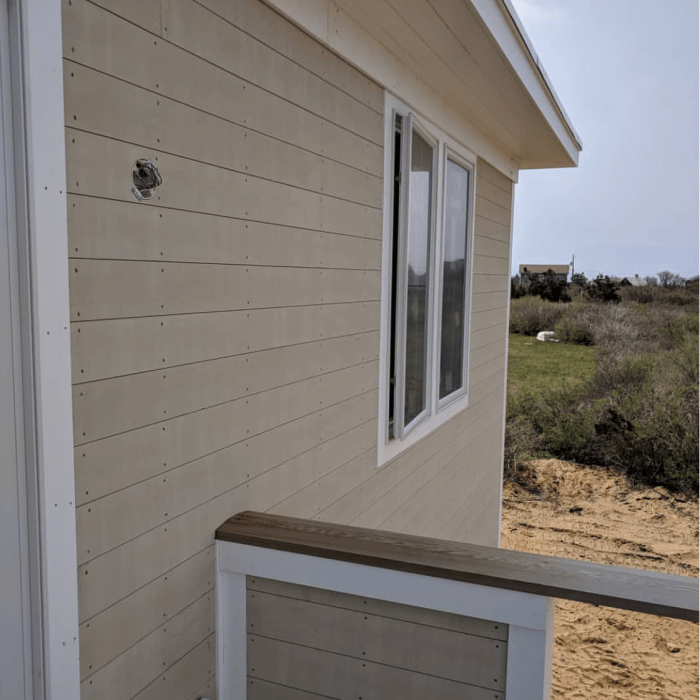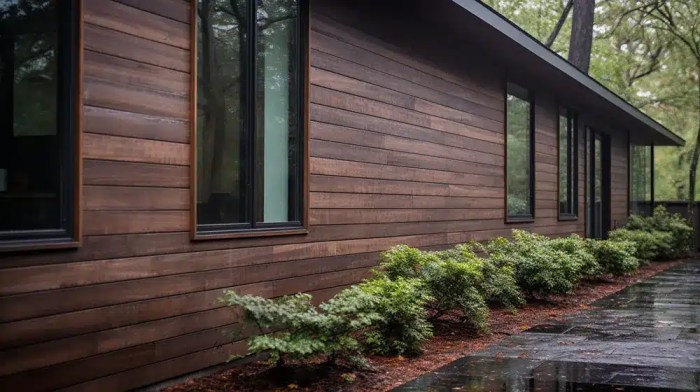Exploring the Beauty of Exterior Shiplap Wood Siding
Delve into the world of exterior shiplap wood siding, a classic yet trendy choice for modern architectural designs. From its rich history to popular usage today, this versatile material offers a unique charm to any home exterior.
Discover the various types of wood used, the installation process, maintenance tips, and design ideas that make shiplap siding a top choice for homeowners looking to enhance their curb appeal.
Introduction to Exterior Shiplap Wood Siding

Exterior shiplap wood siding is a type of exterior cladding made from wooden boards that overlap each other horizontally, creating a distinctive groove between the boards.
Originating from the boat-building industry, shiplap siding gets its name from the way the boards overlap, similar to the construction of ships. This design allowed for better water resistance and durability, making it a popular choice for exterior cladding.
Popularity of Shiplap Siding in Modern Architecture
In modern architecture, shiplap siding has gained popularity due to its rustic charm, versatility, and durability. It is often used to add a touch of warmth and character to both traditional and contemporary homes.
Types of Wood Used in Shiplap Siding
When it comes to exterior shiplap wood siding, the type of wood used plays a crucial role in determining the overall look, durability, and maintenance requirements of the siding. Different types of wood offer varying characteristics and benefits, so it's essential to choose the right one for your specific needs.
Cedar
Cedar is a popular choice for shiplap siding due to its natural resistance to rot, decay, and insects. It is lightweight, durable, and has a beautiful natural color that weathers gracefully over time. However, cedar can be more expensive compared to other wood types, and it requires regular maintenance to preserve its appearance.
Pine
Pine is a cost-effective option for shiplap siding and is readily available. It is easy to work with and can be stained or painted to achieve the desired look. However, pine is less durable than cedar and may require more maintenance to prevent rot and insect damage.
Spruce
Spruce is another affordable option for shiplap siding that offers a clean and uniform appearance. It is lightweight, easy to work with, and can be painted or stained. However, spruce is not as resistant to rot and decay as cedar, so regular maintenance is necessary to prolong its lifespan.
Redwood
Redwood is a high-end option for shiplap siding, known for its natural beauty and durability. It is naturally resistant to rot, decay, and insects, making it a low-maintenance choice. However, redwood is one of the most expensive wood options and may not be suitable for all budgets.
Hardwoods
Hardwoods like oak, maple, and mahogany can also be used for shiplap siding, offering unmatched durability and a rich, luxurious appearance. However, hardwoods are often more expensive and harder to work with compared to softwoods like cedar and pine. They require regular maintenance to prevent warping and weathering.
Installation Process of Exterior Shiplap Wood Siding

Installing shiplap wood siding on the exterior of your home can give it a beautiful, rustic look. Here is a step-by-step guide on how to properly install shiplap siding, along with some tips and common mistakes to avoid.
Preparing the Exterior Surface
Before installing shiplap wood siding, it is crucial to prepare the exterior surface properly. Here are some tips to ensure a smooth installation process:
- Clean the surface thoroughly to remove any dirt, debris, or old paint.
- Repair any damaged areas and ensure the surface is smooth and even.
- Apply a weather-resistant barrier to protect the underlying structure from moisture.
- Prime and paint the surface if necessary to provide a good base for the siding.
Installation Process
Once the exterior surface is prepped, follow these steps to install shiplap wood siding:
- Start at the bottom of the wall and work your way up, ensuring each board overlaps the one below it.
- Use a level to make sure each board is straight and even before nailing it in place.
- Leave a small gap between each board to account for expansion and contraction due to changes in temperature and humidity.
- Secure each board with galvanized nails or screws, making sure to hit the studs for a secure attachment.
- Finish the installation by trimming the edges and corners for a clean, polished look.
Common Mistakes to Avoid
When installing shiplap wood siding, be mindful of these common mistakes to ensure a successful project:
Do not forget to leave gaps between the boards for expansion.
- Avoid using nails that are too long, as they can split the wood or protrude through the other side.
- Do not install the siding too tightly together, as this can lead to buckling and warping.
- Make sure to paint or stain all sides of the boards before installation to protect them from moisture.
Maintenance and Care for Exterior Shiplap Wood Siding

Proper maintenance is essential to ensure that your exterior shiplap wood siding stays in top condition for years to come. By following the right care routine, you can preserve the beauty and longevity of your siding.
Sealing or Painting for Protection
One of the most important steps in maintaining exterior shiplap wood siding is to seal or paint it for protection against the elements. Sealing the wood with a quality sealant helps prevent moisture from seeping in and causing rot or mold.
Painting the siding not only adds a pop of color but also provides an extra layer of protection against UV rays and water damage.
Cleaning and Preserving the Wood
Regular cleaning is crucial to remove dirt, dust, and grime that can accumulate on the surface of the shiplap siding. Use a mild detergent and water solution to gently scrub the wood, avoiding harsh chemicals that can damage the finish.
After cleaning, it's important to apply a fresh coat of sealant or paint to maintain the protective barrier and preserve the wood's natural beauty.
Design Ideas and Trends with Exterior Shiplap Wood Siding
When it comes to exterior design, shiplap wood siding has become a popular choice for homeowners looking to add a touch of rustic charm to their homes. Let's explore some design ideas and current trends with exterior shiplap wood siding.
Common Design Styles with Shiplap Siding
Shiplap siding is commonly used in a variety of design styles, including:
- Cottage or farmhouse style: Shiplap siding is often associated with a cozy and rustic look, making it a perfect fit for cottage or farmhouse-style homes.
- Coastal or beach house aesthetic: The clean lines of shiplap siding can evoke a coastal vibe, making it a great choice for beach house exteriors.
- Modern or contemporary design: Shiplap siding can also be used in modern or contemporary homes to add texture and visual interest to the exterior.
Innovative Ways to Incorporate Shiplap Siding in Exterior Home Design
There are many creative ways to incorporate shiplap siding in exterior home design, such as:
- Accent walls: Use shiplap siding to create a striking accent wall on the exterior of your home.
- Mixing materials: Combine shiplap siding with other materials like stone or brick for a unique and custom look.
- Vertical or horizontal installation: Experiment with different installation patterns to achieve the desired aesthetic for your home.
Current Trends in Colors, Finishes, and Patterns for Shiplap Wood Siding
When it comes to colors, finishes, and patterns for shiplap wood siding, some current trends include:
- Dark hues: Dark-colored shiplap siding is gaining popularity for a more dramatic and modern look.
- Natural finishes: Embrace the natural beauty of wood with clear finishes or stains that enhance the grain of the shiplap.
- Pattern play: Mix and match different widths of shiplap boards to create interesting patterns on your home's exterior.
End of Discussion
In conclusion, exterior shiplap wood siding not only adds character and warmth to your home but also provides a durable and stylish solution for your exterior design needs. Embrace the timeless beauty and functionality of shiplap siding to elevate your home's aesthetic appeal.
User Queries
What are the benefits of using shiplap wood siding?
Shiplap wood siding adds a rustic charm, is durable, and easy to install compared to other siding options.
How often should exterior shiplap wood siding be repainted?
It is recommended to repaint shiplap siding every 5-7 years to maintain its appearance and protect the wood from the elements.
Can shiplap wood siding be used indoors as well?
Yes, shiplap siding is a versatile material that can be used indoors to create a cozy and stylish atmosphere.




